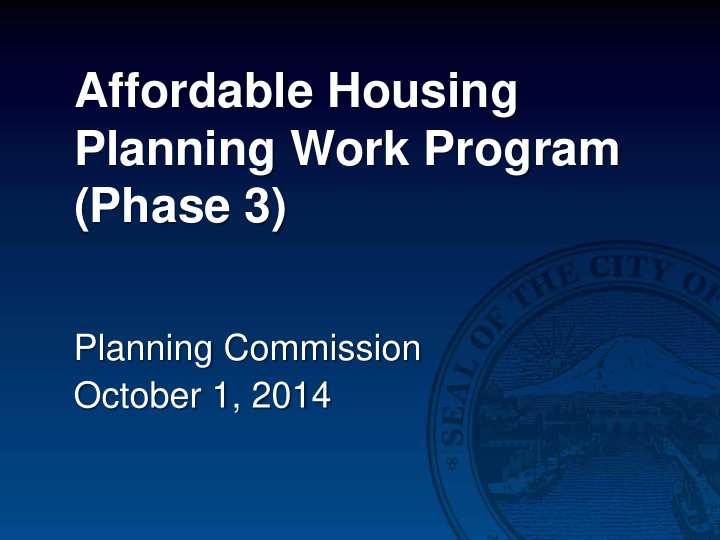



Affordable Housing Planning Work Program (Phase 3) Planning Commission October 1, 2014
Broader Affordable Housing Discussion What is affordable housing in Tacoma? What are we doing to address it? Upcoming initiatives – Consolidated Plan (2015-2020) – Multifamily Tax Exemption Program review – AHPAG Planning recommendations – Housing Element update 2
What Does Affordable Housing Look Like in Tacoma… Income Statistics: Median Household Income: $50,439 Households Earning Less Than $35,000: 27,128 (34.6%) Households Earning Less Than $25,000: 18,771 (23.9%) 3 (Source: American Community Survey 2008-12)
Is housing affordable? Households in Tacoma at median income – $50,439 annually = $1,402 per month for housing Ownership – Tacoma median home price = $187,219 – Monthly homeownership cost = $1,363 (using FHA) Rental (inclusive of utility costs) – 2 bdrm unit @ FMR = $236 net positive – 3 bdrm unit @ FMR = $280 net negative (Median home price source: Trulia) 4
Affordability In Summary City Policy: Help people occupy quality housing affordable to them Promote housing choice and mix in all neighborhoods Key Questions & Strategies: What are the trends in affordability? Can people afford to live here? How to deploy resources to meet need? 5
Affordable Housing Planning Work Program The AHPAG’s Plans and planning-related Policies Housing Land Use recommendations Finance Tools Approaches Jobs, Education, intended to promote Transportation housing affordability Jobs, Education, and mix throughout MFTE Program Transportation, MFTE Program Plans and Policies the City. other… Housing Finance Tools Land Use Approaches
AHPAG Planning Recommendations 1. Infill/Affordable building design practices: – 3.2.1 Expedited permitting – 3.2.5 PRD’s and PARD’s – 3.5.1 ADU’s (detached) – 3.5.2 Cottage housing – 3.5.3 Permit Ready Housing Designs – 3.5.4 Great houses (also, duplexes on corners) – 3.5.5 Group housing – 3.8.1 Small Lots 2. Affordable Housing Incentives: – 3.2.1 Voluntary Housing Incentive Program – 3.2.2 Inclusionary requirements w/ residential upzones – 3.2.3 … w/ City initiated upzones – 3.2.4 … w/ Voluntary Master Planned Communities – 3.2.5 PRD’s and PARD’s – 3.2.7 Transfer of Development Rights
A multi-year effort… 2012-2014: (Phases 1 and 2) – Affordable housing policies strengthened – Code updated to promote affordable options – Subarea planning, review thresholds increased 2015: (Phase 3) – Residential Infill approaches – Incentives and bonuses – Upzones – require affordable units – Process enhancements
Infill strategies Size of the site Accessory Small Lots Denser Cottage Planned Dwelling housing in housing Residential Units single- Districts family zones
Accessory Dwelling Units • Should Tacoma allow Detached ADU’s in single-family areas?
Small lots • Should Tacoma further reduce lot sizes or allow some other flexibilities?
Great houses/duplexes/triplexes • Should Tacoma allow higher density housing in single-family neighborhoods?
PRD’s and cottage housing • Should Tacoma allow cottage/clustered housing, with density bonuses?
Affordable Housing Incentives & Bonuses (proposed) Proposals: Downtown (Floor Area Ratio bonus) Planned Residential Districts density bonus Transfer of Development Rights - affordable housing option Key Issues: Balancing community priorities What’s the right density? Resource demands
Affordability requirement with residential upzones Should Tacoma require affordable housing for approval of upzone requests? Proposal: Capture increased land value/offset cost of providing affordable units Residential upzones - 10% units affordable Private and/or City initiated rezones?
Permit process enhancements Should Tacoma implement housing development permitting enhancements? Proposals: Permit-ready design library Permit review streamlining Fee reductions Issues: Financial and staffing demands Tied to affordable projects?
Why consider infill strategies? Housing affordability, mix and choice Aging in place, workforce housing, property owner flexibility Additional policy objectives Economic development Smart growth Transportation choices Sustainability Health and active living Livability
Infill and residential character (Source: Portland Infill Design Strategies)
What we may hear… 19 Oscar Ruiz, National Geographic
Project approach Fit infill options into zoning framework Non-residential districts R-1 to R-5 Design standards Review process Rezones Incentives, inclusionary, process tools Balancing community priorities What’s the right density? 20 Resource demands
Planning Work Program Objectives – Identify infill approaches supported by community – Promote desired neighborhood character (zoning tools) – Integrate affordable housing into bonus systems – Identify resource demands Housing Element updates 21
Recommend
More recommend